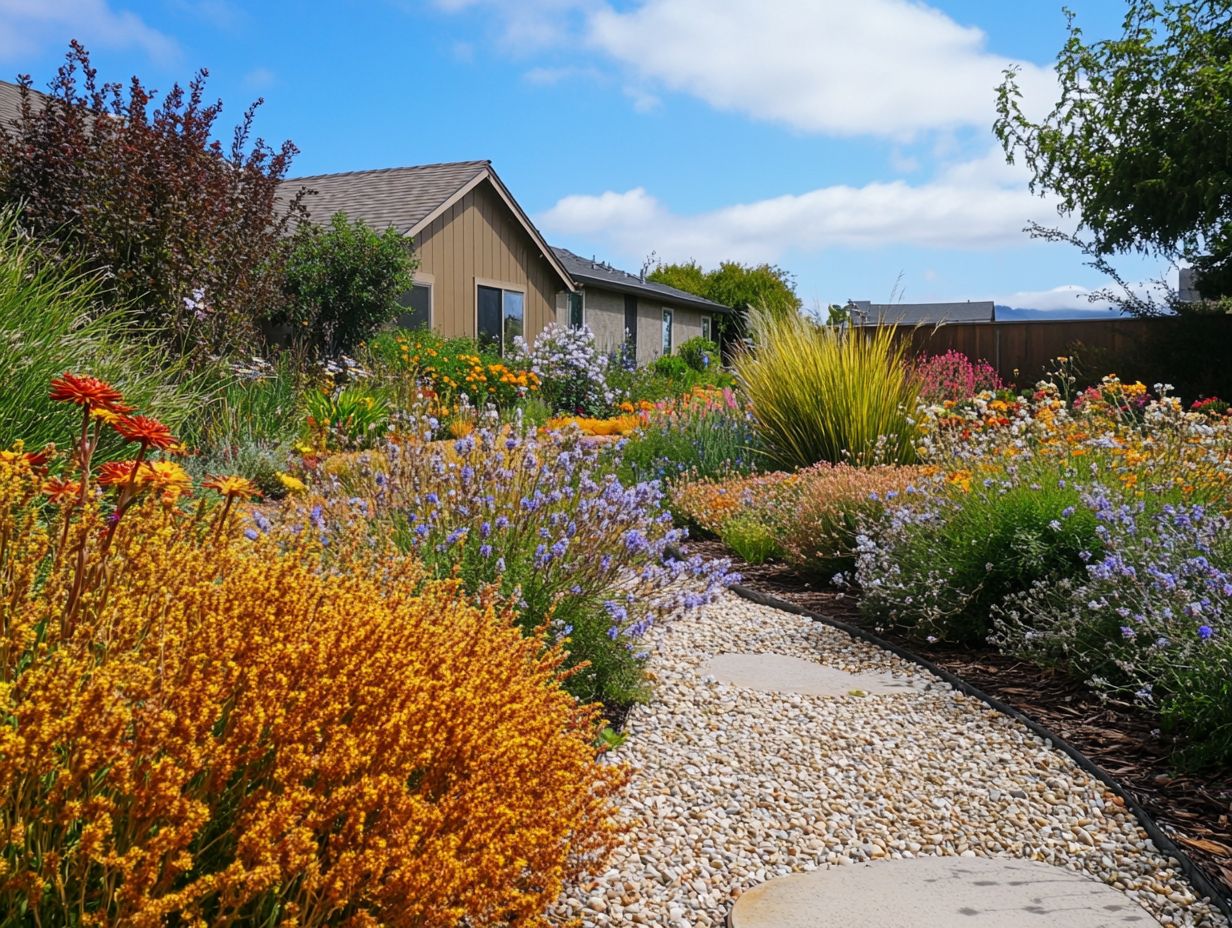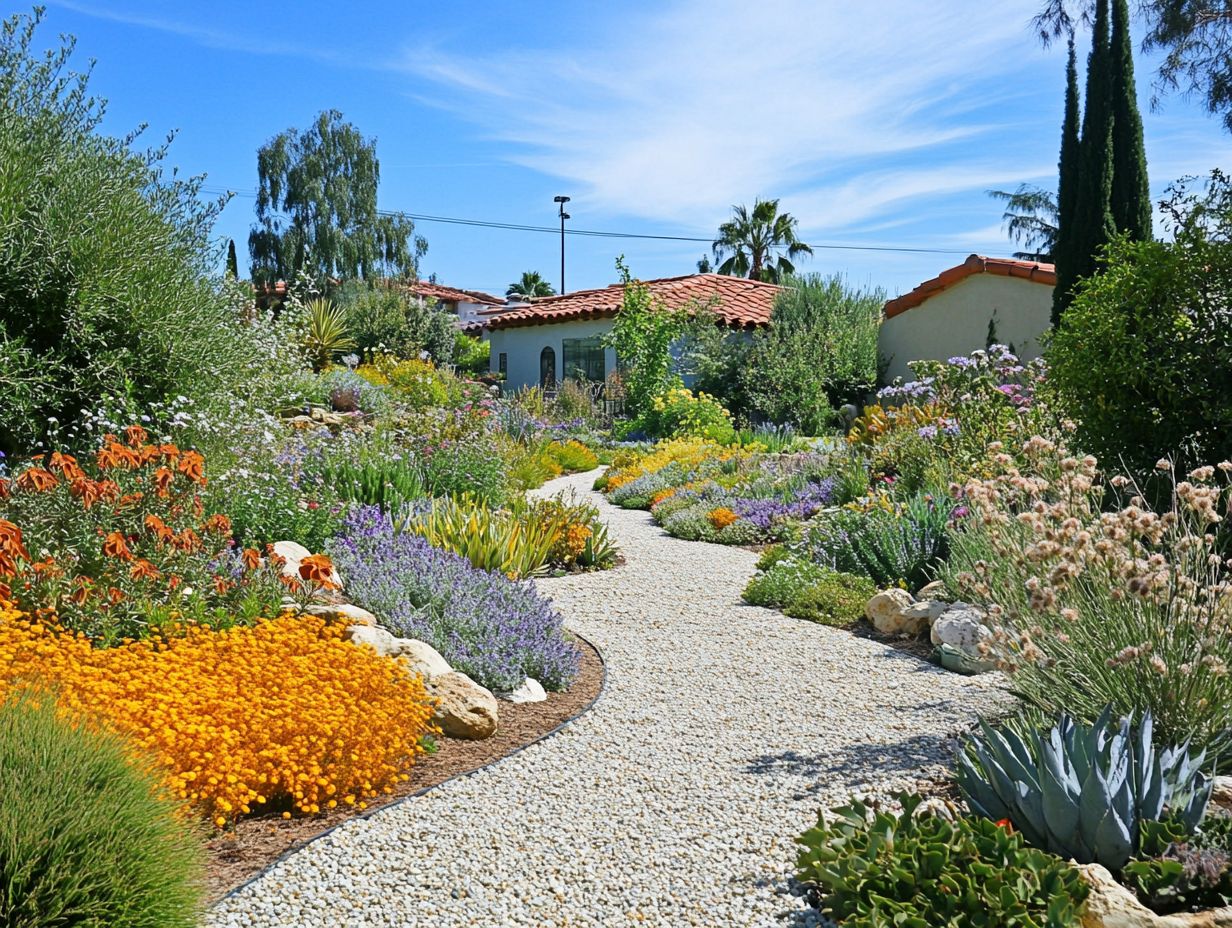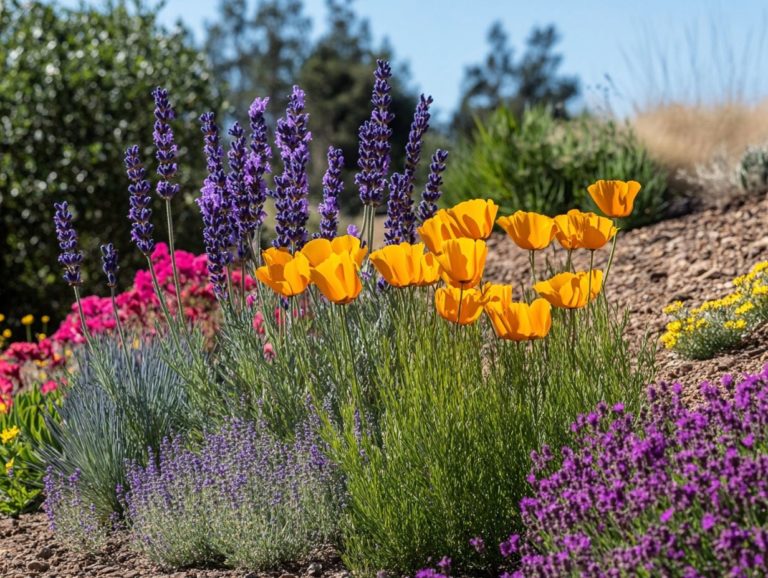Using Gravel in Drought-Friendly Designs
In an era where water conservation is paramount, drought-friendly designs offer elegant solutions for garden challenges.
One material that s gaining traction is landscape rock, celebrated for its versatility and low-maintenance appeal.
This article explores the myriad benefits of using gravel in drought-friendly designs, highlighting its role in promoting water conservation while simplifying maintenance.
You ll discover various types of gravel, explore gardening tips for effective integration, and learn essential practices to ensure your landscape looks its finest.
Embark with us on this journey through the realm of drought-friendly landscaping!
Contents
Key Takeaways:

- Incorporating gravel in drought-friendly designs conserves water while maintaining beautiful gardens.
- Gravel is easy to maintain, requiring minimal upkeep and reducing water use.
- Choosing the right type of gravel and incorporating it strategically creates unique, water-saving landscapes.
What are Drought-Friendly Designs?
Drought-friendly designs focus on creating landscapes that not only thrive in dry conditions but also minimize water use. Integrating plants that can survive with little water, implementing efficient irrigation systems, and using organic mulch contribute to lush environments.
By selecting native plants and employing smart gardening techniques, you can craft stunning gardens that require minimal maintenance while supporting water conservation especially in regions like California, where climate change is increasing the frequency of droughts.
Embracing sustainable practices is crucial if you aim to implement these innovative strategies. Take inspiration from landscape designer Margie Grace, who emphasizes the significance of soil moisture retention and unique landscaping in her projects throughout the San Francisco Bay Area.
Gardening tips such as selecting plants that thrive in dry soils like Mediterranean herbs and California poppies along with mulching to reduce evaporation, can enhance your garden’s resilience against prolonged drought. Using native grasses and succulents not only elevates the aesthetic but also supports local wildlife while reducing the need for supplemental watering and improving soil quality.
This approach showcases a harmonious blend of beauty and practicality in drought-friendly landscaping, emphasizing garden rooms and patio ideas.
Benefits of Using Gravel in Drought-Friendly Designs
Using gravel in drought-friendly designs offers numerous benefits that enhance the aesthetics and functionality of your outdoor spaces. Incorporating water features in drought-tolerant landscapes can further complement your design, allowing for reduced water usage, lower maintenance requirements, and improved soil moisture retention, making it a low-maintenance choice.
Gravel gardens provide a robust surface for paths and seating areas, such as outdoor living rooms, while creating visually captivating environments adorned with vibrant foliage from plants like succulents and California poppies. This approach not only transforms your landscape but also aligns with sustainable practices, making your outdoor haven both beautiful and environmentally friendly.
Water Conservation
Water conservation highlights the necessity of efficient irrigation systems to maintain plant health while minimizing water consumption. Use strategies like drip irrigation. Choose drought-tolerant plants such as lavender, rosemary, thyme, and succulents to manage your water resources without sacrificing your garden’s aesthetic appeal.
Incorporate techniques like collecting rainwater for reuse and smart irrigation controllers to elevate your water efficiency. These innovative technologies automatically adjust watering schedules based on the weather, significantly cutting down on waste and supporting sustainable practices.
Applying organic mulch, such as wood chips or straw, is essential for retaining soil moisture by curbing evaporation and regulating temperature. This blend of advanced irrigation methods and natural soil enhancers allows you to cultivate sustainable landscapes that thrive, ensuring your plants receive the hydration they need while conserving precious water resources and employing eco-friendly practices.
Low Maintenance

Low-maintenance gardening gives you the power to craft stunning gardens that require minimal upkeep while showcasing beautiful and practical garden styles. By choosing native plants and embracing sustainable practices like organic mulch and landscape cloth, along with unique elements like a stone vessel or a firepit, you’ll dramatically reduce your maintenance time while enjoying vibrant outdoor spaces adorned with ornamental grasses and succulents.
Enhancing your soil with organic matter and compost improves fertility and water retention, fostering healthier plant growth and supporting effective soil improvements. As you plan the layout, consider incorporating unique landscaping elements like rock gardens or gravel paths to create beautiful gardens that harmonize with nature. These features not only reduce maintenance demands but also add captivating visual appeal.
Grouping plants with similar water requirements simplifies irrigation and contributes to a harmonious design. By prioritizing these thoughtful choices, you can cultivate an inviting garden that is both environmentally friendly and low on maintenance demands.
Types of Gravel for Drought-Friendly Designs
When contemplating drought-friendly designs, you ll find a variety of gravel types, such as crushed rock and landscape rock. Each brings unique characteristics that enhance both the visual and functional appeal of your outdoor spaces.
Whether it s crushed rock or landscape rock, choosing the right gravel not only enhances aesthetics think gravel frames and winding paths but also promotes effective drainage and minimizes water usage in your sustainable garden, making it essential for garden rooms.
Start your journey towards a beautiful, water-wise garden now!
Options and Characteristics
When selecting gravel for drought-friendly designs, it s essential to understand the various options available and their unique characteristics, such as texture, color, and drainage capabilities. Choosing gravel that promotes proper drainage is crucial for maintaining soil moisture for drought-tolerant plants. It also enhances the aesthetics of your garden space, making it a key element in any garden design!
Consider the different types of gravel:
- Pea gravel, with its rounded edges, offers excellent drainage and feels soft underfoot.
- Crushed stone, known for its angular particles, locks together to create a stable surface, perfect for gravel paths.
Each type brings distinct advantages to your garden layouts!
For example, decorative gravels like decomposed granite not only reflect sunlight beautifully but also help moderate soil temperatures. This can significantly benefit plant health, especially for drought-tolerant species.
The color of your chosen gravel can either complement or contrast with the surrounding flora. This influences the visual harmony of the space, making it a vital consideration in your landscape design. Understanding these granular choices can elevate both the functionality and design of your drought-tolerant gardens, creating unique and sustainable outdoor spaces!
How to Incorporate Gravel in Drought-Friendly Designs
Incorporating gravel into your drought-friendly designs can truly elevate your outdoor spaces! It transforms them into functional areas that harmonize beautifully with drought-tolerant plant selections while enhancing their visual appeal, particularly in an outdoor living room setting.
Using design strategies like:
- Crafting winding gravel paths
- Creating inviting outdoor living rooms
- Designing seating areas framed by vibrant foliage
By incorporating elements like a firepit, you can establish a unique landscaping aesthetic that flourishes even in arid conditions!
Design Tips and Techniques

Effective design tips and techniques for integrating gravel into your drought-friendly garden can significantly elevate both the aesthetic and functionality of your outdoor space! This creates an inviting and sustainable environment that promotes water conservation.
Using gravel paths establishes visual breaks and defines seating areas. This guides visitors through your lush garden filled with native plants and ornamental grasses.
Incorporating a variety of gravel sizes and colors introduces texture and contrast that beautifully complements the surrounding flora. This enhances the overall design elements of your garden! Opting for permeable gravel, which allows water to flow through, promotes natural drainage, reduces runoff, and fosters a healthier ecosystem while retaining soil moisture.
Edging your gravel with locally sourced stones or low-growing plants, such as lavender or thyme, not only delineates clear boundaries but also adds biodiversity to your landscape. This creates a more inviting space for wildlife.
When placed thoughtfully, gravel can act as a focal point, drawing attention to key areas! It promotes sustainable gardening practices, including water-saving techniques that minimize watering needs and maximize design versatility.
Maintaining Gravel in Drought-Friendly Designs
Maintaining gravel in drought-friendly designs is essential for both the longevity and aesthetic appeal of your outdoor spaces! It offers you a low-maintenance solution as a gardener in California.
To ensure your gravel remains in top shape, conduct regular checks to prevent weed growth. Maintain efficient drainage and refresh gravel surfaces while considering maintenance tips to enhance its durability. This attention to detail keeps your pathways and garden frames looking beautiful and inviting!
By following these tips, you ll enhance the overall charm of your landscape and create a true garden room! Start your own drought-friendly garden design with gravel today!
Proper Care and Maintenance
Proper care and maintenance of gravel areas in your drought-friendly designs requires you to use simple methods for weed prevention. This ensures that the surfaces remain clean and functional. Consider layering landscape cloth beneath the gravel. This simple trick will dramatically cut down your weed problem while preserving the integrity of pathways and seating areas.
Make it a habit to rake regularly. This keeps the gravel evenly distributed for a polished look and helps prevent pesky weeds from establishing. Employing mulch or gravel barriers around your planting zones acts as a strong deterrent against invasive species and minimizes your maintenance efforts.
Remember to check for any loose stones or depressions regularly. Filling in these gaps is crucial for maintaining a stable walking surface and inhibiting weed growth. By embracing these practices, you can cultivate a cohesive and resilient landscape that thrives even with limited water availability.
Frequently Asked Questions
What is the purpose of using gravel in drought-friendly designs?

Gravel is often used as a low-maintenance alternative to grass in drought-friendly designs. It helps conserve water by reducing the need for regular watering and adds visual interest to the design.
How can gravel be incorporated into a drought-friendly design?
Gravel can be applied in various ways in a drought-friendly design. It serves as ground cover to replace grass, borders around plants and flower beds, or as a decorative element in pathways or rock gardens.
What are the benefits of using gravel in a drought-friendly design?
Using gravel not only reduces water usage but also helps prevent soil erosion and weeds. It is also a more cost-effective option compared to maintaining a lawn.
What types of gravel are best for drought-friendly designs?
When choosing gravel for a drought-friendly design, consider the size and color. Small, angular gravel is ideal for pathways and borders, while larger, rounder gravel is better for ground cover. Neutral colors like beige and gray are popular choices.
How should gravel be installed in a drought-friendly design?
Before installing gravel, prepare the area by removing existing vegetation and leveling the ground. A layer of landscape fabric can be used to prevent weeds. Spread the gravel evenly to a depth of 2-3 inches.
Are there any maintenance tasks involved with using gravel in a drought-friendly design?
While gravel requires minimal maintenance, it is recommended to periodically rake or sweep the surface to keep it looking neat and remove any debris. It may also need to be replenished over time as it can shift or become compacted.
Start your project now and transform your space into a drought-friendly oasis!






